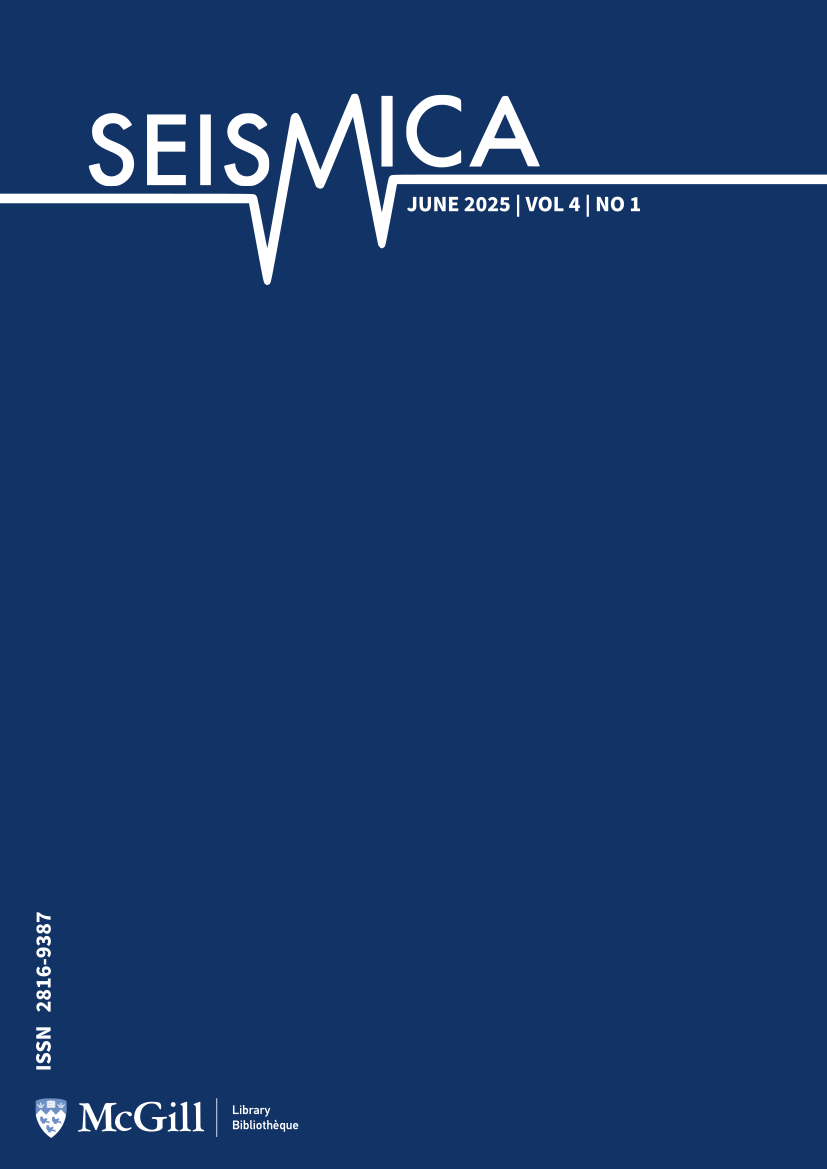DOI, licence and citation uptake for seismological waveform data after 10 years of implementation effort
DOI:
https://doi.org/10.26443/seismica.v4i1.1537Keywords:
Seismology, FDSN, DOI, Licence, Citation, Seismic Networks, FAIRAbstract
The International Federation of Digital Seismic Networks (FDSN) has championed online open access to seismological waveform data for almost four decades. In 2014, FDSN recommended using DataCite Digital Object Identifiers (DOIs) for seismic networks to enhance data attribution, citation, and impact metrics. This study evaluates the level of adoption of DOIs and licences across FDSN-registered networks, analyzing their influence on data citation and compliance with FAIR (Findability, Accessibility, Interoperability, and Reusability) principles. 73% of seismic networks that have an assigned FDSN network code have adopted DOIs, with more than 80% DOI coverage for networks created after 2014. Licence adoption, not covered by present FDSN recommendations, remains low (8%), with significant regional variations. The main challenges are presently barriers to systematic data citation, whether on scientist or publisher side. Citations have increased substantially, but improvements are needed to support and implement correct data citation across all levels, including networks, data centers, scientists and journals. Of specific concern is the limitation on references set by some journals, which renders proper attribution impossible for studies using data from many seismic networks. This work highlights best practices and provides a set of recommendations for improving attribution, citation, and FAIRness of seismological waveform data, the latter including that FDSN should recommend licence on waveform data and a limited set of recommended licences. It also explores emerging ethical considerations, like the CARE principles, for Indigenous Data Governance. These insights aim to guide future FDSN strategies and foster enhanced alignment with FAIR and CARE principles. An added value of the assessment was that many minor errors and inconsistencies were identified and fixed at FDSN and in the seismological metadata.
References
Agarwal, D., Ayliffe, J., Buck, J., Damerow, J., Parton, G., Stall, S., Stockhause, M., & Wyborn, L. (2025). Complex Citation Working Group Recommendation Version 3. Zenodo. https://doi.org/10.5281/zenodo.14106602
Beyreuther, M., Barsch, R., Krischer, L., Megies, T., Behr, Y., & and Wassermann, J. (2010). ObsPy: A Python Toolbox for Seismology. Seismological Research Letters, 81(3), 530–533. https://doi.org/10.1785/gssrl.81.3.530 DOI: https://doi.org/10.1785/gssrl.81.3.530
Carroll, S. R., Garba, I., Figueroa-Rodríguez, O. L., Holbrook, J., Lovett, R., Materechera, S., & Parsons, M. et al. (2020). The CARE Principles for Indigenous Data Governance. Data Science Journal, 19(43), 1–12. https://doi.org/10.5334/dsj-2020-043 DOI: https://doi.org/10.5334/dsj-2020-043
Carroll, S. R., Herczog, E., Hudson, M., Russell, K., & Stall, S. (2021). Operationalizing the CARE and FAIR Principles for Indigenous data futures. Scientific Data, 8, 108. https://doi.org/10.1038/s41597-021-00892-0 DOI: https://doi.org/10.1038/s41597-021-00892-0
Dziewonski, A. M. (1994). The FDSN: history and objectives. Annals of Geophysics, 37(5). https://doi.org/10.4401/ag-4191 DOI: https://doi.org/10.4401/ag-4191
Evans, P. L., Strollo, A., Clark, A., Ahern, T., Newman, R., Clinton, J. F., Pedersen, H., & Pequegnat, C. (2015). Why seismic networks need digital object identifiers. Eos, 96. https://doi.org/10.1029/2015EO036971 DOI: https://doi.org/10.1029/2015EO036971
Heinloo, A. (2024). fdsnws_scripts: a collection of next generation distributed data request tools based on FDSN web services and the EIDA routing service. GFZ Data Services. https://doi.org/10.5880/GFZ.2.4.2024.002
Indigenous Data Lab. (2024). Indigenous Metadata Bundle Communique. https://doi.org/10.6084/m9.figshare.24353743.v1.
International Federation of Digital Seismograph Networks. (2013). FDSN Web Service Specifications Version 1.0. https://fdsn.org/webservices/FDSN-WS-Specifications-1.0.pdf.
International Federation of Digital Seismograph Networks. (2023). FDSN recommendations for seismic network DOIs and related FDSN services. International Federation of Digital Seismograph Networks (FDSN). https://doi.org/10.7914/D11596.
Kukutai, T. (2024). How Indigenous communities in New Zealand are protecting their data. Science, 384(6691). https://doi.org/10.1126/science.ado9298 DOI: https://doi.org/10.1126/science.ado9298
Kukutai, T., Campbell-Kamariera, K., A., M., Mikaere, K., Moses, C., Whitehead, J., & D., C. (2023). Māori data governance model. . Te Kāhui Raraunga. https://www.kahuiraraunga.io/_files/ugd/b8e45c_803c03ffe532414183afcd8b9ced10dc.pdf
Liggins, L., Hudson, M., & Anderson, J. (2021). Creating space for Indigenous perspectives on access and benefit-sharing: Encouraging researcher use of the Local Contexts Notices. Molecular Ecology, 30, 2477–2482. https://doi.org/10.1111/mec.15918 DOI: https://doi.org/10.1111/mec.15918
Marignier, A., Eakin, C., Hejrani, B., Agrawal, S., & Hassan, R. (2024). Sediment thickness across Australia from passive seismic methods. Geophysical Journal International, 237(2), 849–861. https://doi.org/10.1093/gji/ggae070 DOI: https://doi.org/10.1093/gji/ggae070
Mestel, E. (2023). Seismicity, sub-surface structure and partnership with Tangata Whenua of Taupō Volcano [Phdthesis]. Te Herenga Waka-Victoria University of Wellington.
O’Brien, M., Duerr, R., Taitingfong, R., Martinez, A., Vera, L., Jennings, L., Downs, R., Antognoli, E., ten Brink, T., Halmai, N., & David-Chavez, D. (2024). Earth Science Data Repositories: Implementing the CARE Principles. Data Science Journal, 23(37), 1–29. https://doi.org/10.5334/dsj-2024-037 DOI: https://doi.org/10.5334/dsj-2024-037
Pedersen, H. A., Mattern, F., Poli, P., & and Stehly, L. (2023). Imaging with seismic noise: improving extraction of body wave phases from the deep Earth through selective stacking based on H/V ratios. Geophysical Journal International, 232(2), 1455–1467. https://doi.org/10.1093/gji/ggac388 DOI: https://doi.org/10.1093/gji/ggac388
Petrakopoulos, V., & Schaeffer, J. (2024). find-net-board. https://hal.science/hal-04820268v1
Quinteros, J. (2017). Routing Service: A data centre federation for the seismological community. GFZ German Research Centre for Geosciences. https://doi.org/10.5880/gfz.2.4.2017.001
Romanowicz, B., & Dziewonski, A. (1986). Toward a federation of broadband seismic networks. EOS, 81(67), 541–542. https://doi.org/10.1029/EO067i025p00541 DOI: https://doi.org/10.1029/EO067i025p00541
Schultes, E., Magagna, B., Hettne, K. M., Pergl, R., Suchánek, M., & Kuhn, T. (2020). Reusable FAIR Implementation Profiles as Accelerators of FAIR Convergence. In G. Grossmann & S. Ram (Eds.), Advances in Conceptual Modeling (pp. 138–147). Springer International Publishing. https://doi.org/10.1007/978-3-030-65847-2_13 DOI: https://doi.org/10.1007/978-3-030-65847-2_13
Semken, S., Fouch, M., Garnero, E., Zah, P., & Lippert, D. (2007). Meshing American Indian concerns with goals of EarthScope’s USArray. EOS, 88(31), 309–310. https://doi.org/10.1029/2007EO310001 DOI: https://doi.org/10.1029/2007EO310001
Stall, S., Bilder, G., & Cannon, M. et al. (2023). Journal Production Guidance for Software and Data Citations. Scientific Data, 10, 656. https://doi.org/10.1038/s41597-023-02491-7 DOI: https://doi.org/10.1038/s41597-023-02491-7
Wilkinson, M., Dumontier, M., & Aalbersberg, I. et al. (2016). The FAIR Guiding Principles for scientific data management and stewardship. Science Data, 3, 160018. https://doi.org/10.1038/sdata.2016.18 DOI: https://doi.org/10.1038/sdata.2016.18
Downloads
Additional Files
Published
How to Cite
Issue
Section
License
Copyright (c) 2024 Helle A. Pedersen, Jonathan Schaeffer, Florian Haslinger, Rob Casey, Javier Quinteros, Lesley Wyborn, Elisabetta D’Anastasio, Jonathan B. Hanson, Jerry Carter

This work is licensed under a Creative Commons Attribution 4.0 International License.



